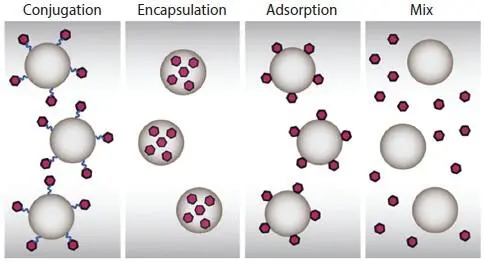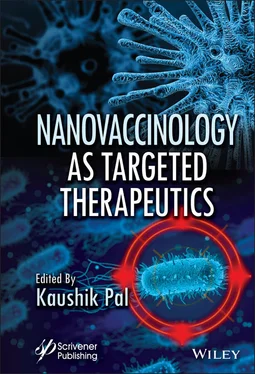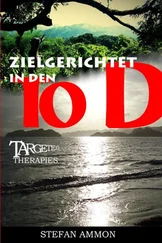Nanovaccinology as Targeted Therapeutics
Здесь есть возможность читать онлайн «Nanovaccinology as Targeted Therapeutics» — ознакомительный отрывок электронной книги совершенно бесплатно, а после прочтения отрывка купить полную версию. В некоторых случаях можно слушать аудио, скачать через торрент в формате fb2 и присутствует краткое содержание. Жанр: unrecognised, на английском языке. Описание произведения, (предисловие) а так же отзывы посетителей доступны на портале библиотеки ЛибКат.
- Название:Nanovaccinology as Targeted Therapeutics
- Автор:
- Жанр:
- Год:неизвестен
- ISBN:нет данных
- Рейтинг книги:3 / 5. Голосов: 1
-
Избранное:Добавить в избранное
- Отзывы:
-
Ваша оценка:
- 60
- 1
- 2
- 3
- 4
- 5
Nanovaccinology as Targeted Therapeutics: краткое содержание, описание и аннотация
Предлагаем к чтению аннотацию, описание, краткое содержание или предисловие (зависит от того, что написал сам автор книги «Nanovaccinology as Targeted Therapeutics»). Если вы не нашли необходимую информацию о книге — напишите в комментариях, мы постараемся отыскать её.
Nanovaccinology as Targeted Therapeutics
Nanovaccinology as Targeted Therapeutics — читать онлайн ознакомительный отрывок
Ниже представлен текст книги, разбитый по страницам. Система сохранения места последней прочитанной страницы, позволяет с удобством читать онлайн бесплатно книгу «Nanovaccinology as Targeted Therapeutics», без необходимости каждый раз заново искать на чём Вы остановились. Поставьте закладку, и сможете в любой момент перейти на страницу, на которой закончили чтение.
Интервал:
Закладка:
This book also covers the hottest topics based on nanovaccinology applications in the field of therapeutics and nanodetectors as per biomedical applications. It is enhanced by the welcomed contributions of biotechnologists, nanotechnologists, biochemists, medical biologists, pharmacists, materials scientists as well as academicians and research scholars. There is every indication that with appropriate liability and regulation along-side the topics, commercial production of manufactured novel composite materials can be realized. Furthermore, the diverse brilliant innovations and explorations highlighted throughout the entire book can modulate spectroscopic performances with technical excellence in the inter- and cross-multidisciplinary research of high competence.
Lastly, I would like to express my overwhelming gratitude to all the authors and co-authors for their excellent research contributions to this book. I also wish to thank the entire team at Wiley-Scrivener for their consistent support during even the most difficult stages of its publication. I am confident that within a short period of time the eBook series will be very popular in university and institute libraries worldwide, and hopefully will be highly cited in coming years.
Dr. Kaushik PalMay 2022
1
Nanotechnology in Vaccine Development and Constraints
Tahmina Foyez 1 and Abu Bin Imran 2*
1 Department of Pharmaceutical Sciences, School of Health and Life Sciences, North South University, Dhaka, Bangladesh
2 Department of Chemistry, Bangladesh University of Engineering and Technology, Dhaka, Bangladesh
Abstract
Generally, vaccinations are the most efficient prophylactic measures against infectious diseases. Despite the obvious advantages of vaccines, optimizations are required due to poor immunogenicity, instability, toxic effect, and the necessity for multiple dose of a vaccine. Nanotechnology have currently been introduced into vaccination research to address these difficulties. The nanotechnology in vaccine development can improve immune responses. Particle size at the nanoscale is critical for this benefit. Nanoparticles (NPs) used in the formulation of vaccine can improve stability of antigen and immunogenicity while also allowing for targeted distribution. A variety of NPs vaccines have been permitted for human use, with composition, size, shape, and surface qualities. However, obstacles are present because of a lack of proper knowledge of NPs activity in vivo , which can be used as a delivery mechanism to improve antigen processing to boost immunity. We have discussed the recent achievements of nanotechnology in vaccine delivery systems in this chapter, emphasizing the different carriers, such as polymeric NPs, liposomes, emulsions, and carbon-based nanomaterials. The basic knowledge of in vivo biocompatibility, toxicity, and stability of nanotechnology-based vaccine delivery systems has also been discussed.
Keywords:Nanotechnology, nanovaccinology, antigen, antibody, nanoparticles
1.1 Introduction
Currently, infectious diseases are the primary cause of mortality. They are caused by microorganisms like viruses, bacteria, fungi, or other parasites. The human immune system fights and removes foreign invading particles [1, 2]. A vaccine is a living, dead, attenuated, inactivated form of a pathogenic microbe, such as a bacterium or virus, or a component of the pathogenic microbe’s structure, which enhances antibody production in the host body but is incapable of causing severe illness [3]. It develops immunity to control and adjust our immune systems from over-reactivity or underactivity [4, 5]. Vaccines have become an everyday part of life, providing a high-impact benefit to human by preventing or managing a wide range of diseases. Vaccine development has a long and glorious history that started late in the 18th century. Louis Pasteur’s laboratory’s first attempts to vaccine development [6]. The development of vaccines is crucial to the successful control of many deadly diseases. However, efficient preventative and therapeutic vaccinations for totally healing lethal diseases and major microbial infections have yet to be produced. On the other hand, critical challenges that need to be addressed include the design, manufacture, and global distribution of vaccines. To design a vaccine, the antigen, adjuvant, manufacturing method, and delivery strategy should be established. Antigen is a pathogen-derived foreign substance that can elicit an immunological response within the host. A vaccine can be classified into four types based on its antigen: live-attenuated vaccine, inactivated vaccine, subunit vaccine, and peptide-based vaccine. Adjuvants are immunomodulatory agents that are used to boost immune reaction. The first adjuvant, aluminum was designed to boost the production of antibodies, making it an excellent choice for vaccine development [7, 8]. If genetic and structural information about microorganisms is known, vaccinations can be developed quickly. Nanotechnology platforms are particularly beneficial in current vaccine development and have accelerated the testing of novel prospective vaccines. Recently nanoparticles (NPs), as vaccine delivery vehicles, have received tremendous attention. Nanovaccine formulations not only improve antigen integrity and immunity, but they also provide selective distribution and sustained release. A wide range of NPs antigens with varying physicochemical properties have been authorized for clinical use [9–11]. The primary goal of using NPs delivery methods is to delay antigen presentation and uptake by dendritic cells (DCs), resulting in immediate DC activation [9, 11, 12]. Antigen and adjuvant are also protected from early enzyme and protease degradation by NPs [13]. Vaccine antigens can be administered to the target site by enclosing them in NPs or conjugated particles ( Figure 1.1). NPs can be designed with peptide, protein, polymer, and other targeting ligands for vaccine formulations due to their unique physical and chemical properties, including as greater surface area, variable shape and size with various surface charges, and other targeting ligands. Although NPs have the benefits listed above, they also have drawbacks, such as a lack of mechanical stability under physiological conditions due to protein corona development and unfavorable interactions with the endothelial system [14, 15]. Biocompatible NPs have improved physical stability while avoiding unwanted interactions with immune cells and boosting blood supply [16, 17], which imitate biological membranes. The nanovaccines that use carrier biomimetic NPs allow prolonged circulation and avoid cytotoxicity when delivered to the body [18].

Figure 1.1 The interactions of NPs with the target antigen. Reproduced (adapted) from [19]. Copyright 2013, Elsevier.
Nanotechnology has opened the way for developing novel vaccines based on nanomaterials, which have unique qualities and serve as antigenic delivery systems and immunomodulatory substances. Multiple research groups in the area are developing nanovaccines for a variety of diseases, and tremendous advantages from this nanotechnology are expected in the coming decades for both animal and human health.
1.2 Nanoparticles, an Alternative Approach to Conventional Vaccines
As an alternative to traditional vaccinations, the utilization of NPs exhibiting relevant antigenic moieties seems promising. These NPs might come from biological or synthetic sources. Inorganic NPs, polymer NPs, liposomes, virus-like particles (VLPs) NPs, and self-assembled protein NPs are among the antigen carriers currently being studied ( Figure 1.2). Many biological systems, including infectious agents and biomolecules, are nanoscale in size [20]. NPs have been injected subcutaneously or intramuscularly, and they have the ability to pass through capillaries [21]. Recent advancements have made it possible to create NPs with distinct physical and chemical characteristics. The shape, size, solubility, surface composition, and so on can all be tuned and manipulated, allowing for the development of NPs with particular biological features. They can also be engineered to include a variety of compounds, including antigens, making them extremely valuable in vaccine development [22, 23]. Antigens can be incorporated into NPs through encapsulation or conjugation [24]. The native structure of antigens can be protected against proteolytic breakdown by NPs, and antigen transportation to antigen-presenting cells (APCs) can be improved [25]. Furthermore, NPs containing antigens have a local depot effect to ensure the presence of antigens in immune cells for a longer period of time [26]. Interestingly, carbon black (CB) NPs, carbon nanotubes (CNTs), poly lactic-co glycolic acid (PLGA) NPs, titanium dioxide (TiO 2) NPs, and silicon dioxide (SiO 2) NPs have all been shown to exhibit intrinsic immunomodulatory properties [27]. In point of fact, once ingested by APCs, these NPs transmit a signal that promote proteolytic degradation and the induction of oxidative stress, resulting in the release of lysosomal contents [28, 29]. These features indicate that NPs could be useful antigen transporters and innate immune stimulators in vaccinations.
Читать дальшеИнтервал:
Закладка:
Похожие книги на «Nanovaccinology as Targeted Therapeutics»
Представляем Вашему вниманию похожие книги на «Nanovaccinology as Targeted Therapeutics» списком для выбора. Мы отобрали схожую по названию и смыслу литературу в надежде предоставить читателям больше вариантов отыскать новые, интересные, ещё непрочитанные произведения.
Обсуждение, отзывы о книге «Nanovaccinology as Targeted Therapeutics» и просто собственные мнения читателей. Оставьте ваши комментарии, напишите, что Вы думаете о произведении, его смысле или главных героях. Укажите что конкретно понравилось, а что нет, и почему Вы так считаете.












